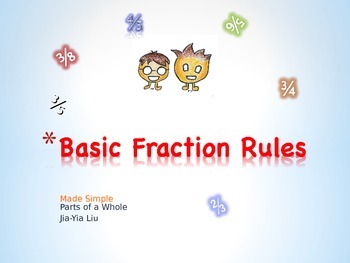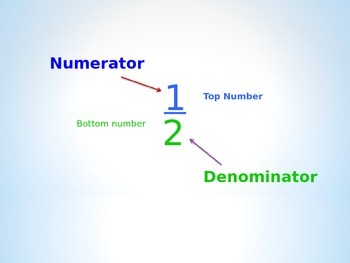PowerPoint Fraction Rules; As Part of a Whole
Simple Concepts
28 Followers
Grade Levels
1st - 3rd, Homeschool
Subjects
Resource Type
Standards
CCSS3.NF.A.1
CCSS3.NF.A.3
CCSS3.NF.A.3a
CCSS3.NF.A.3b
CCSS3.NF.A.3c
Formats Included
- PPT
Pages
38 pages
Simple Concepts
28 Followers
Description
This is an animated PowerPoint presentation on fractions as a part of a whole. This is the second presentation in my Basic Fraction Rules series designed to aid teachers to introduce students to the world of fractions. This visual aid helps students group items and express parts of a whole in fractions. Example of everyday items are used to illustrate concepts. Interactive questions are designed to engage active participation. Word Problems are used to stimulate creative thinking and introduce children to apply fractions to their everyday lives. One slide can teach multiple points however the animation allows the lecturer to present one idea clearly at a time walking the students through the main concepts. We hope you and your students will enjoy learning from this presentation as much as my 3rd grader and I enjoyed creating it. Let me know what you need and I will gladly try to create it.TOU: Purchase/download of this product allows the purchaser to make copies for personal classroom use only. Posting on the internet in any way, using illustration for commercial purposes, distributing/copying for an entire grade level, school or district is strictly forbidden without permission from the author. http://creativecommons.org/licenses/by-nc/4.0/
Total Pages
38 pages
Answer Key
Included
Teaching Duration
30 minutes
Report this resource to TPT
Reported resources will be reviewed by our team. Report this resource to let us know if this resource violates TPT’s content guidelines.
Standards
to see state-specific standards (only available in the US).
CCSS3.NF.A.1
Understand a fraction 1/𝘣 as the quantity formed by 1 part when a whole is partitioned into 𝘣 equal parts; understand a fraction 𝘢/𝑏 as the quantity formed by 𝘢 parts of size 1/𝘣.
CCSS3.NF.A.3
Explain equivalence of fractions in special cases, and compare fractions by reasoning about their size.
CCSS3.NF.A.3a
Understand two fractions as equivalent (equal) if they are the same size, or the same point on a number line.
CCSS3.NF.A.3b
Recognize and generate simple equivalent fractions, (e.g., 1/2 = 2/4, 4/6 = 2/3). Explain why the fractions are equivalent, e.g., by using a visual fraction model.
CCSS3.NF.A.3c
Express whole numbers as fractions, and recognize fractions that are equivalent to whole numbers. Examples: Express 3 in the form 3 = 3/1; recognize that 6/1 = 6; locate 4/4 and 1 at the same point of a number line diagram.





